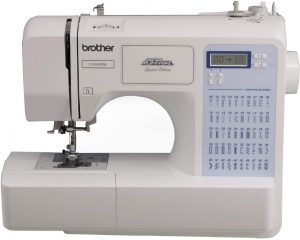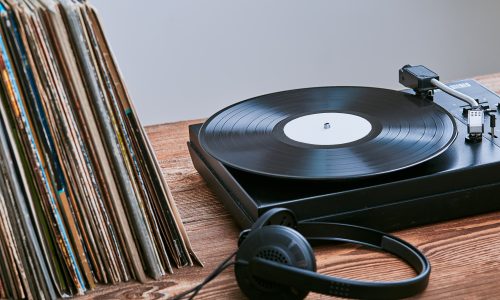The Best Sewing Machine
Crafting Must-Haves: Check out these top picks for crafters now on sale at Amazon.

Our Review Process
Don't Waste Your Money is focused on helping you make the best purchasing decision. Our team of experts spends hundreds of hours analyzing, testing, and researching products so you don't have to. Learn more.
Our Picks For The Top Sewing Machines
- 1. Magicfly Battery Powered Mini Beginner Sewing Machine
- 2. KPCB Compact Rewinding Pole Beginner Sewing Machine
- 3. Brother Computerized Sewing Machine, 60-Stitch
- 4. Varmax Beginner Mini Sewing Machine
- 5. MICHLEY Stainless Steel Compact Sewing Machine, 12-Stitch
- 6. Brother Electric Sewing Machine, 50-Stitch
- 7. SINGER Reverse Stitch Sewing Machine, 110-Stitch
- 8. Brother Treadle Powered Sewing Machine, 27-Stitch
- 9. Brother Advanced Needle Threader Sewing Machine, 185-Stitch
- 10. Singer Adjustable Electric Sewing Machine, 11-Stitch
- 11. W-Dragon Travel Manual Sewing Machine
Whether you're looking to teach your daughter how to sew, or you simply want to learn yourself, this beginner sewing machine is an excellent choice. It has an affordable price tag and comes in a choice of blue or purple and white. A 42-piece sewing accessory kit is included with the machine, which means you'll be able to create your first project a...
Budget-Friendly PriceThis beginner sewing machine offers two speeds and features both an extension table and a built-in light.
Since this beginner sewing machine is compact, you'll be able to take it to grandma's for a sewing lesson. It's made with a rewinding pole and can sew up to five layers of fabric without issue. As an added bonus, the machine comes with a 42-piece sewing kit to get you started.
Travel-Friendly OptionYou can power this beginner sewing machine using batteries or with the provided adapter.
This sewing machine with 60 stitches is perfect for beginner sewers who are ready to learn new skills. The machine has an automatic needle threader and adjustable sewing speed. However, it cannot handle thick material like leather.
Lightweight Choice for New SewersThis sewing machine simplifies the sewing process with built-in stitches and free arm capability.
Included with this sewing machine is a sewing kit with everything you need to get started. It's an excellent model for students and teens, as it's easy to use and smaller in size than other models. You can even get this machine in purple, orange or blue.
Most EconomicalThe budget-friendly price tag on this sewing machine makes it a great choice for those just starting out or those who need a backup model.
Buying Guide
Whether you’ve been sewing for years or are just picking it up as a new skill, having your own sewing machine at home is the way to go. With so many different brands and models available on the market, it’s difficult to know which sewing machine is right for you. You’ll want to keep in mind the kind of projects you’re interested in working on, and your skill level and familiarity with sewing fundamentals.
“There’s an entire spectrum of options which can quickly become overwhelming so before you begin shopping, ask yourself a few questions about your sewing goals,” says Vicki Liston, our home improvement expert and host of “On the Fly…DIY,” an award-winning home improvement show. “What’s your current skill level? Are you looking for something with minimal bells and whistles, only meant to do simple tasks or do you want the equivalent of a sewing robot? Do you want to expand your skills and learn more about the craft? Are you a pro and need to make quick work of your projects? Do you have a special interest, like embroidery or quilting? Approaching your sewing machine purchase with a well-rounded picture of where you are, what you want to do, and how much you want to learn will help you pick the best one for you.”
There are two main types of sewing machines you can try: mechanical and computerized. For new sewers and those who are brushing up on their skills, a mechanical sewing machine is a good starting point. For sewing experts and professionals, a computerized sewing machine may be a better choice. A computerized sewing machine comes with many bells and whistles that a mechanical machine does not. However, to truly take advantage of those features, you have to understand the fundamentals of sewing – which you can better learn on the mechanical model.
One of the most important features to ensure your sewing machine has is the built-in needle threader. This is a task you need to do every time you sew. Even for those with steady hands and 20/20 vision, threading a needle can take time. A built-in needle threader makes this task easy and quick.
Another feature to consider when looking for a sewing machine is the top-loading drop-in bobbin. With this feature, you don’t need to disassemble a bobbin casing to get it in. Plus, this system usually has a transparent cover plate, so you can see when you run out of thread.
“I can’t tell you how excited I was when I learned that ‘drop-in bobbins’ and ‘self-threading needles’ were a thing,” says Liston. “These miraculous features would have saved me so much frustration and wasted time as I was learning to sew. If your budget allows it, I highly recommend a unit with these options as they are life-changing!”
If you want the ability to sew cylindrical pieces such as pant hems, sleeves and headbands, then you’ll want a sewing machine that has free-arm capability. Many beginner sewing machines do not have this capability, so watch out for that as it can limit the kind of projects you work on.
Our Expert Consultant

Home Improvement Expert
Vicki Liston writes, produces, and narrates “On The Fly…DIY,” an award-winning home improvement and DIY show of unique project tutorials for the casual DIY’er.
Home improvement and all things DIY have been Liston’s passion since she bought her first house in 2007 and she started making video blogs in 2014. She’s performed hundreds of DIY projects, from small ones to major, wall-smashing renovations and can teach you how to make a trendy DIY barn door for cheap. The proceeds earned from “On The Fly…DIY” are donated to no-kill animal shelters and rescue organizations.
What to Look For
- “Whatever your sewing aspirations, I only recommend purchasing a machine with a metal frame,” says Liston. “It’s much cheaper and easier to find plastic-framed models but they won’t last as long and they are harder to fix. The same goes for the inner workings, like gears. Opt for metal and not plastic. You’ll get a much longer life out of your unit.”
- When you’re on the hunt for a sewing machine, take into account the kind of stitches it can do and whether that is what you need for your projects. Some of the basic stitches that most people will require are the straight stitch, zig-zag stitch, buttonhole stitch, knit stitch, blind hem stitch and utility stitches. The Brother Computerized Sewing Machine with 60 Stitches has an easy stitch-selector switch so you can see and pick the kind of stitch you want. The electric version has five auto-size buttonholes in addition to its many stitches. The Brother Computerized Sewing Machine, 130 Stitches comes with eight styles of auto-size buttonholes and 55 alphanumeric sewing stitches. Other models are designed to be used for small on-the-spot repairs and alterations.
- In addition to the built-in needle threader, top-loading drop-in bobbin and free-arm capability, you may need some additional features on your sewing machine, such as adjustable speed control, needle position adjustment, lighting and knee lifter capability. The Brother Computerized Sewing Machine with 60 Stitches has an automatic needle threader, adjustable speed control and a built-in free arm. Others use an automatic needle threader, drop-in bobbin and an LCD screen.
- The attachments and feet you will need for your sewing machine will depend on the kind of projects you plan to sew. If you’re a quilter, you will need a walking foot, spring action foot and a ¼-inch foot. On the other hand, if you’re sewing garments, you will need a zipper foot, buttonhole foot, overcast stitching foot and button attaching foot. The Brother Computerized Sewing Machine, 130 Stitches comes with six sewing feet attachments.
- For some sewers, a full sewing machine isn’t necessary. If you’re only looking to do small alterations, then a portable sewing machine may be what you need. Consider a cordless hand-held machine that runs on batteries, so it can be taken on the go. This type is often designed to be used on many different materials, including denim, wool, silk and leather, and is also suitable for crafts. It may also be useful for sewing hanging curtains or tapestries.
More to Explore
Sewing is an art form that is tens of thousands of years old. However, mechanical or computerized sewing machines are only a recent invention. Thousands of years ago, sewing was done by hand using needles that were made of bones or animal horns. The thread was created using animal sinew. It wasn’t until the fourteenth century that iron needles were invented. One hundred years after that, the first eyed needles were created.
In the late 1700s and early 1800s, many inventors in Europe and America attempted to develop the first mechanical sewing machine that replicated hand sewing. However, there were many failures as the machines weren’t able to complete the tasks required. It wasn’t until around 1830 that the first functional sewing machine was invented.
French tailor Barthelemy Thimonnier developed a machine that used one thread and a hooked needle. The kind of stitch the machine made was similar to embroidery. However, people were not pleased with his invention. Thimonnier was almost killed by an angry mob of French tailors. They burnt down his garment factory in a rage. The reason? They were terrified that his sewing machine invention would put them out of work because it could sew much faster than they could by hand.





















